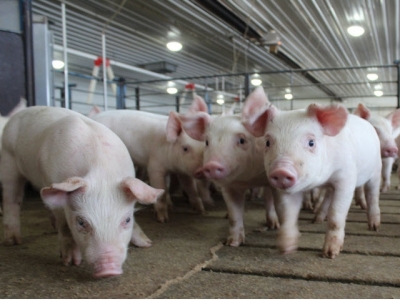What are the benefits of higher amino acid fortification of pig and poultry diets?

Livestock production is expect to double by 2050, but there is little room to expand arable land so reducing farmed animals’ intake of crude protein is an effective strategy, argues Professor Ermias Kebreab, from the University of California, Davis, in the US.
Higher fortification of poultry and pig feed with synthetic amino acids is one way to reduce the use of crude protein such as soybean meal (SBM) levels in monogastric diets, he said. In Europe, such dietary intervention could address the protein deficit by lowering the region’s dependence on soy imports, he added.
Professor Kebreab was speaking at FeedNavigator’s inaugural face-to-face event, Feed Protein Vision 2018, held in Amsterdam earlier this month.
He presented on the research work he has been involved in that evaluated the environmental impact of using specialty feed ingredients such as amino acids (AA).
The use of feed grade amino acids could see a reduction in the inclusion of imported SBM in European pig and poultry formulas by over 50%.
Besides contributing to protein rich feedstuffs substitution, AAs can also positively influence animal metabolism and reduce the nitrogen upload into the environment.
“Environmental impact is considerably improved by using feed grade amino acids: greenhouse gases (GHG) are reduced by 56 and 54% in pigs and broilers, while eutrophication potential is lowered by up to 35% in pig and 49% in poultry.”
However, the successful implementation of reduced CP diets lies on a deep knowledge of AA requirements.

Knowledge gaps
Increasing knowledge about the nutritional value of feedstuffs is required to ensure optimal use of AAs in pig and poultry diets, he said.
“There has been a lot of work done to look at what is the digestibility of different feed ingredients, and that one of the limitations right now, because those need to be done constantly. A number of universities and feed companies are using this.
“As more and more information becomes available [in this regard] that it will be better for precise feed formulation as well. We need to do more of this work to make sure we understand the ileal digestibility elements within different feed ingredients.”
Moreover, the swine sector is somewhat ahead of the poultry industry in terms of knowing how to achieve diets containing lower levels of crude protein.
“There has been a lot more work done to show that there is a big advantage in supplementing pigs’ diets with amino acids, and that will reduce the crude protein intake. There has been some work done in poultry as well, but so far there has been more success in pig rather than in poultry systems.”
Low CP pig diets with probiotics and fiber
The CP level in pig diets can be reduced by at least two percentage points without affecting performance and carcass quality when balanced for essential amino acids (SID basis; ideal AA ratio) and net energy (NE), said John Htoo, director global technical support, swine, at Evonik.
He was speaking at Feed Protein Vision 2018 as well.
Htoo showed how diets based on grains and SBM results into excess levels of CP and AAs, and that formulation of low CP diets using supplemental AAs are more cost effective and more environmentally friendly.

The integrated approach of using low CP pig diets with probiotics and fiber sources further improves gut health and nutrient efficiency of pigs, he said.
He also demonstrated how reducing the dietary CP by two percentage points for production of 55 million pigs - 25-115 kg - in Germany has potential to reduce:
- 50,000 tons less N excretion (7 million tons less of slurry)
- 2.5 million ton less CO2e global warming potential (11% reduction)

In terms of piglets, he said lowering dietary CP can reduce hindgut ammonia concentration and diarrhea incidence in the young animals.
Related news
 Three ways to implement piglet creep feeding
Three ways to implement piglet creep feeding Creep feeding is a well-known practice, but it is not always successful. Here’s how to make it work at your pig farm.
 More studies needed to back up use of antibiotic alternatives in pig diets: review
More studies needed to back up use of antibiotic alternatives in pig diets: review The most commonly used feed additives in pig diets are acidifiers, zinc and copper, prebiotics, probiotics, yeast products, nucleotides, and plant extracts.
 Using organoids to unravel feed efficiency in pigs
Using organoids to unravel feed efficiency in pigs Proof of principle shows organoids may be used to study complex traits like feed efficiency.